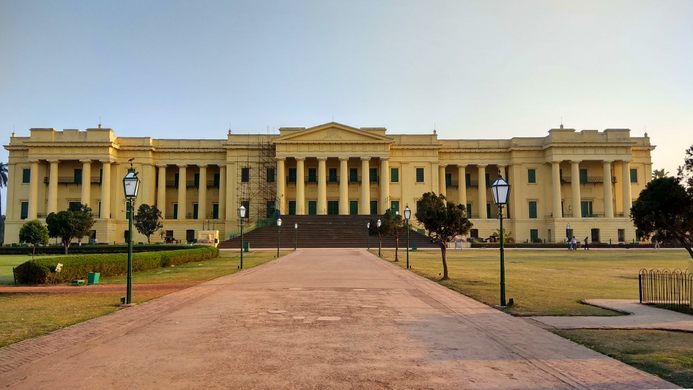AO Edited
Hazarduari Palace
In the palace with a thousand doors, not all of them are guaranteed to lead you somewhere new.
Hazarduari Palace of Murshidabad in the Indian state of West Bengal has all the pomp and grandeur of Bengal’s Nawabi culture. Hazarduari, which translates to “a thousand doors” in Hindi, is situated a few meters from the river Bhagirathi, the lifeline of this town.
The grand yellow-colored Italian-style palace with Greek Doric columns was designed by architect Duncan Macleod for Sayyid Mubarak Ali Khan II, popularly known as Humayun Jah, the Nawab of Bengal, Bihar, and Orissa. Jah laid the foundation stone of the palace in 1829 and was inaugurated in 1838. “Human Jah wanted to make a palace that looked like Buckingham Palace in London,” said Asif Meerza, a descendant of the Nawab family. “But after completion, he didn’t like it to make his residence. Instead, it was used as a Durbar and office where all the important ceremonies like a coronation, parties, and public meetings were held.”
The palace does in fact have 1,000 doors, but only 900 of them are real. The palace’s 100 fake doors were built to mislead the enemy attackers. This massive three-storied rectangular building spreads 424 feet long and 200 feet broad, with main gates large enough to allow an elephant with a howdah, or carriage, to pass through. Nawabs referred to the palace as Bari Kothi, but many locals preferred to call it Hazarduari because of the number of doors. Eventually, the government recognized its official name as Hazarduari Palace.
After the Nawabs, Hazarduari Palace was restored by the Archaeological Survey of India and has been converted into a museum that has a huge display of artifacts used by the Nawabs of Bengal and the British Empire.
More than 100 rooms in the palace have been divided into different sections displaying jewelry, clothes, thrones, cars, cutlery, antiques, furniture, armory, and paintings. The museum’s ground floor has a display of armory including guns, spears, armor, swords, daggers, and cannons used in several battles fought by the Nawabs. The second and third floors have displays of furniture, chandeliers, clothes, and a library featuring rare books and manuscripts from the 18th and 19th centuries. Though it is not open to the public, researchers and scholars can use it with prior permission from the museum. The hallway and the rooms have a huge collection of beautiful oil paintings and marble statues.
One of the most fascinating items in the museum is a mystery mirror, where the person who stands in front of it cannot see themselves, but others can. The mirror was planned to be placed at 90 degrees, to mislead the invaders who could harm the Nawab before they could realize that they were the target. This magic mirror is placed outside the gallery, and visitors try the experiment to know the story’s relevance.
Outside the museum, you can see the huge, white Nizamat Imambara facing the palace. Other features in the Hazarduari complex include a clock tower, Yellow Masjid, and the Bacchhawali Tope, a cannon that is believed to have been fired only once. The sound of the cannon was said to be so strong that it induced child delivery in most pregnant women within a 10-mile radius. Hence the name Bachhawali Tope, which means the cannon which produces childbirth.
Know Before You Go
The entry ticket to the museum is priced at INR 25 for Indians and natives of SAARC countries while people from other nationalities have to pay INR 300. The museum is closed on Fridays and photography is not allowed inside the palace.
Community Contributors
Added by
Edited by
Plan Your Trip
The Atlas Obscura Podcast is Back!























Follow us on Twitter to get the latest on the world's hidden wonders.
Like us on Facebook to get the latest on the world's hidden wonders.
Follow us on Twitter Like us on Facebook